Van leeuwenhoek 1673 - Study guides, Class notes & Summaries
Looking for the best study guides, study notes and summaries about Van leeuwenhoek 1673? On this page you'll find 9 study documents about Van leeuwenhoek 1673.
All 9 results
Sort by
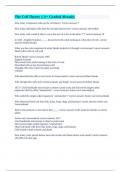
-
The Cell Theory || A+ Graded Already.
- Exam (elaborations) • 6 pages • 2024
-
- $10.69
- + learn more
How many component make up the cell theory? correct answers 7 How many individual cells does the average human have? correct answers 100 trillion How many cells would it take to cover the area of a dot on the letter "i"? correct answers 50 In 1665 - English Scientist, ____, discovered cells while looking at a thin slice of cork. correct answers Robert Hooke What was the cork comprised of when Hooke looked at it through a microscope? correct answers Dead xylem cells of cell wall ...
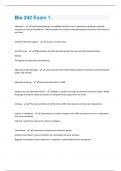
-
Bio 242 Exam 1 Questions and Answers Solved
- Exam (elaborations) • 8 pages • 2024
- Available in package deal
-
- $7.99
- + learn more
Absortion - Upon encountering a susceptible host the virus is adsorbed by binding to specific receptors on the cell membrane. These receptors are similar to the glycoproteins found on the surface of viral coat acellular infectious agents - viruses, viroids, prions acid fast stain - Differentiates acid-fast bacteria (pink) from non-acid-fast bacteria (blue). detects The agents of tuberculosis and leprosy. Agricultural Microbiology - concerned with the relationships between microbes and dom...
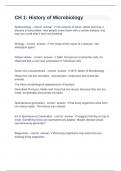
-
CH 1: History of Microbiology Question and answers verified to pass
- Exam (elaborations) • 5 pages • 2024
-
Available in package deal
-
- $12.99
- + learn more
CH 1: History of Microbiology Question and answers verified to pass Epidemiology - correct answer The science of when, where and how a disease is transmitted. How people come down with a certain disease, that way you could stop it from out breaking Etiology - correct answer The study of the cause of a disease, "the etiological agent" Robert Hooke - correct answer 1665, first person to describe cells, he observed that a cork was composed of "individual cells Anton Van Leeuwenhoe...
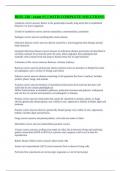
-
BIOL 240 - exam #1 || WITH COMPLETE SOLUTIONS.
- Exam (elaborations) • 4 pages • 2024
- Available in package deal
-
- $10.49
- + learn more
symbiosis correct answers Refers to the partnership (usually long term) that is established between 2 or more organisms 3 kinds of symbiosis correct answers mutualism, commensalism, parasitism Pathogen correct answers anything that causes disease infectious disease correct answers disease caused by a microorganism that disrupts normal body functions emergent infectious disease correct answers an infectious disease previously not described or not been common for at least the prior 20 ...
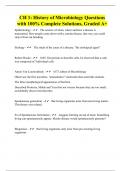
-
CH 1: History of Microbiology Questions with 100% Complete Solutions, Graded A+
- Exam (elaborations) • 5 pages • 2024
-
Available in package deal
-
- $11.99
- + learn more
Epidemiology - The science of when, where and how a disease is transmitted. How people come down with a certain disease, that way you could stop it from out breaking Etiology - The study of the cause of a disease, "the etiological agent" Robert Hooke - 1665, first person to describe cells, he observed that a cork was composed of "individual cells Anton Van Leeuwenhoek - 1673, father of Microbiology Observed- the first microbes- "animalcules"=molecules that acted like a...

-
Bio 242 Exam 1 Questions With 100% Correct Answers.
- Exam (elaborations) • 7 pages • 2024
- Available in package deal
-
- $7.99
- + learn more
Prokaryote - Answer-A unicellular organism that lacks a nucleus and membrane bound organelles. Bacteria and Archaea. Eukaryote - Answer-organism whose cells contain a nucleus and membrane bound organelles. Fungi, protozoa, algea, parasatic worms, acellular infectious agents - Answer-viruses, viroids, prions Medical Microbiology - Answer-Deals with microbes that cause diseases in humans and animals Public Health Microbiology and Epidemiology - Answer-monitor and control the spread of diseas...
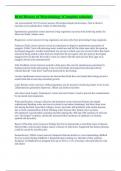
-
Brief History of Microbiology (Complete solution)
- Exam (elaborations) • 2 pages • 2023
- Available in package deal
-
- $7.99
- + learn more
van Leeuwenhoek (1673) correct answers Developed simple microscopes. First to observe microbes (wee animalcules). Father of Microbiology Spontaneous generation correct answers living organisms can arise from nonliving matter Ex: Moist soil toads, snakes, mice Biogenesis: correct answers living organisms can arise only from preexisting living organisms Francesco Redi correct answers set up an experiment to disprove spontaneous generation of maggots. Filled 2 jars with decaying meat, seal...
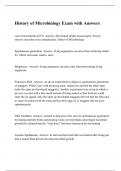
-
History of Microbiology Exam with Answers
- Exam (elaborations) • 4 pages • 2023
-
Available in package deal
-
- $9.99
- + learn more
van Leeuwenhoek (1673) Answer- Developed simple microscopes. First to observe microbes (wee animalcules). Father of Microbiology Spontaneous generation Answer- living organisms can arise from nonliving matter Ex: Moist soil toads, snakes, mice Biogenesis: Answer- living organisms can arise only from preexisting living organisms Francesco Redi Answer- set up an experiment to disprove spontaneous generation of maggots. Filled 2 jars with decaying meat, sealed one and left the other op...
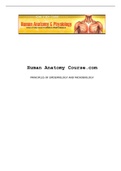
-
PRINCIPLES OF EPIDEMIOLOGY AND MICROBIOLOGY
- Exam (elaborations) • 121 pages • 2022
-
- $14.79
- + learn more
TABLE OF CONTENTS Lesson Paragraphs INTRODUCTION 1. INTRODUCTION DISEASE TRANSMISSSION AND EPIDEMIOLOGY 1-1—1-13 Exercises 2. PUBLIC HEALTH MIVROBIOLOGY Section I. Introduction 2-1—2-5 Section II. Bacteria 2-6—2-11 Section III. Virsus 2-12—2-15 Section IV. Fungi 2-16—2-20 Section V. Protozoa 2-21—2-23 Section VI. Helminths Exercises 2-24—2-28 3. PRACTICAL APPLICATION OF MICROBIOLOGY Section I. Microbiology of Water and Sewage 3-1—3-2 Section II. Disinfec...

Study stress? For sellers on Stuvia, these are actually golden times. KA-CHING! Earn from your study resources too and start uploading now. Discover all about earning on Stuvia


